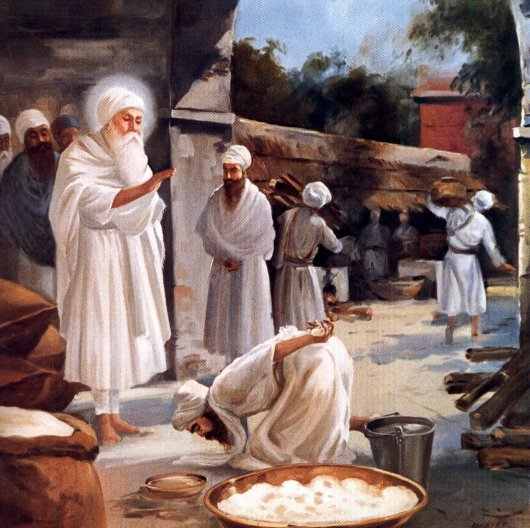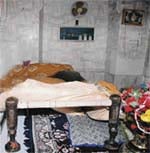Manji System
The Manji or Manji System along with the Piri System, were innovative systems established by the third Guru, Guru Amar Das, Ji at Goindwal to spread Sikhi across Punjab and India under a logical and well planned method of administration. Twenty two devoted Gursikhs, all noble, devout men and women (called sangatia or masands) were appointed by Guru Amar Das Ji to spread Guru Nanak Dev Ji’ s message, provide spiritual guidance, and keep the Sangat (congregation) in touch with Guru Nanak Dev Ji’s message. Each Manji (dioceses) was also responsible for the offerings of each Sangat (the Dasvand), which they made in token of their reverence to the Guru. The Sikhs' offering was used for langar, (the community kitchen) and after meeting the expenses of the local chapters, the surplus was to be passed on to the Guru’s golak (the community chest) at Goindwal.
Goindwal was becoming a very busy place, with ever increasing numbers of Sikhs coming to have the Guru's Darshan. Therefore, the Guru's presence had become necessary. Guru Ji wanted to allow his disciples to be able to keep their normal routine life, but by doing this, he hoped that they could all be taught equally in the discipline of Sikhi.
The word Manji refers to the low wooden cots on which the Sikh Sangatia would sit and teach the Sikhi doctrines and principles to their sangats and sing Shabads (hymns), followed in chorus by the congregation.
22 manjis
The 22 Manjis were spread throughout Punjab, Haryana, Himachal Pardesh, Pakistan and Afghanistan.
| S. No. | Name | Belong to | Region Given |
| 1 | Bhai Allah Yaar | Delhi | Delhi |
| 2 | Bhai Beni | ||
| 3 | Bhai Bua | ||
| 4 | Bhai Darbari | Majitha | |
| 5 | Bhai Gangu Shah | Simaur, Himachal | |
| 6 | Bhai Handal | Jandiala Guru area | |
| 7 | Bhai Kedari | ||
| 8 | Bhai Kheda | ||
| 9 | Bhai Lalu | ||
| 10 | Bhai Mahesha | Sultanpur | Sultanpur Area |
| 11 | Bhai Mai Das | Tarn Taran, Amritsar area | |
| 12 | Bhai Manak Chand | ||
| 13 | Bhai Matho & Bibi Murari | Chunian, Kasur area | |
| 14 | Bhai Paro | ||
| 15 | Bhai Phera | Mirpur(J&K) | J&K Area |
| 16 | Bhai Raja Ram | ||
| 17 | Bhai Rang Das | Gharooan(near Kharar) | Ropar District |
| 18 | Bhai Rang Shah | Jalandhar, Nawanshahr area | |
| 19 | Bhai Sadharan | ||
| 20 | Bhai Sawan Mall | ||
| 21 | Bhai Sukhan | ||
| 22 | Bibi Sachan Sach |
Summary of 22 Manjis
- Alayar also called Allah Shah was a Pathan trader who became the Guru's Sikh and was entrusted with the first Manji to spread Sikh faith.
- Sachan Sach was a Brahman from Mandar village in Lahore district. He always used the words 'Sachan Sach' and so he was called Sachan Sach. One of the queens of the Raja of Haripur became insane, and by the grace of the Guru, she recovered her sanity. The Guru married her to Sachan Sach. The couple preached Sikhism.
- Sadharan was an inhabitant of Goindwal who was given a Manji for his devotion to the Guru.
- Sawan Mal was a nephew of Guru Amar Das. The Guru sent him to Haripur in Kangra district to procure timber for the construction of houses in Goindwal. Sawan Mal propagated Sikh gospel in that area.
- Sukhan was an inhabitant of Dhamian village in Rawalpindi district where he preached Sikhism.
- Handal was from Jandiala village in Amritsar district. He rendered great service in Guru's kitchen.
- Bhai Kedari was an inhabitant of Batala in Gurdaspur district. He was a very famous devotee of the Guru.
- Kheda was from Khemkaran village in Lahore district. He was a devotee of Durga goddess before he became Guru's Sikh.
- Gangu Shah was an inhabitant of Garh Shankar. The Guru sent him to preach Sikhism in Sarmaur state.
- Bhai Darbari was from Majitha village in Amritsar district.
- Bhai Paro was a Sikh of Guru Angad. He was an inhabitant of Dalla. His devotion got him the eleventh Manji.
- Bhai Phera was an inhabitant of Mirpur in Jammu area. He was a disciple of the Jogis before he became Guru Amar Das's Sikh. He preached Sikhism in that hilly area.
- Bhai Bua became Guru's Sikh and was blessed with Nam, the fragrance of which he spread around his area.
- Beni was a learned Pandit of Chunian in Lahore district. He was proud of his knowledge of Hindu Shastras and he defeated many in the debate of that knowledge. When he came to Goindwal, he fell on the feet of the Guru and became his Sikh. The Guru entrusted him with the fourteenth Manji.
- Mahesa was an inhabitant of Sultanpur and he performed missionary work in that area.
- Mai Das's preached Sikhism in Majha area.
- Manak Chand was drowned in the Bawli and then revived by the Guru, the Sikhs called him Marjiwra- the revived after death. His generation is called Marjiwre in Vairowal village in Amritsar district. Manak Chand was made a spiritual guide to Mai Das by the Guru.
- Murari whose original name was Prema, was an inhabitant of Khai village in Lahore district. A leper he, aAfter hearing about Guru Amar Das, came crawling all the way to Goindwal. By the grace of the Guru, he was fully healed and renamed as Murari. The Guru married him to Matho, daughter of Bhai Sihan. He was then sent out as one of the Itinerant preachers of the Guru's gospel.
- Raja Ram was a Brahman. He became Guru's Sikh. Many of his decendants now live in Sandhma village of Jullundhur district.
- Rang Shah was an inhabitant of Malupote village in Jullundhur district. He propagated Guru's faith in Doaba area.
- Rang Das was from Gharooan village (near Kharar) now in Rupar district.
- Lalo was an inhabitant of Dalla and was a famous Vaid (doctor). He became Guru's Sikh and preached Guru's gospel.
Classification acc to Regions
Here are the initial 16 names of the people (of 22 manjis) he appointed to preach Sikhism.
- 1. Manak Chand Jhinwar (Water Carrier) at Variowal in Amritsar.
- 2. Sada ram, a Blacksmith near Amritsar.
- 3. Hindal at Jandiala near Amritsar.
- 4. Gangu Shah banker at Lahore.
- 5. Mutho-Murari (also mentioned as "Matho Murrari"), a devoted couple, at Chunian in Lahore Dist.
In Jallandar Doab
- 6. Paro Julka at Jalandar.
- 7. Mahesh Dhir at Sultanpur Lodi.
In Kangra Hills
- 8. Sawan mal, Nephew of Guru Amar Das, at Haripur Guler.
- 9. Name not given, at Dharamsala.
Kashmir Hills
- 10. Phirya at Mirpur.
Malwa (Area of Patiala, Ludhiana, Bhatinda)
- 11. Kheira at Firozpur.
- 12. Mai Das Bairagi in charge of Ludhiana dist.
- 13. Mai Bhago at village Wayun, tehsil Kharar, dist. Rupar.
- 14. Mai Sewan at Village Gardnoh in Patiala District.
- 15. Sachna Shah in charge of Ambala distt.
Sind
- 16. Lalu in charge of some area in Sind.
- 17 to 22 Are Unknown
Routine of Devout Sikhs
Guru Amar Das was impressed with Bhai Gurdas' thorough knowledge of Hindi and Sanskrit and the Hindu scriptures. Following the tradition of sending out Masands across the country, Guru Amar Das deputed Bhai Gurdas to Agra to spread the gospel of Sikhism. Before leaving, Guru Amar Das prescribed the following routine for Sikhs:
"He who calls himself a Sikh of the True Guru, He must get up in the morning and say his prayers. He must rise in the early hours and bathe in the holy tank. He must meditate on God as advised by the Guru. And rid himself of the afflictions of sins and evil. As the day dawns, he should recite scriptures, and repeat God's name in every activity. He to whom the Guru takes kindly is shown the path. Nanak! I seek the dust of the feet of the Guru's Sikh who himself remembers God and makes others remember Him." (Gauri)
Manji Of Bhai Mai Das
A more than four-and-a-half-century old “manji” (cot / or one of the 22 dioceses) established by Guru Amar Das is still intact at Gurdwara Manji Sahib. The gurdwara was raised in memory of Bhai Mai Manak Das in the border village near zero line. The Narli village of Majha region came to be one of the major centres of Sikhism following the establishment of the “manji”.Guru Amar Das copied the old system of administration when he set up his 22 “manjis”. Bhai Mai Das held one of these.
Bhai Mai Das, a strict Vaishnav came in contact with Guru Amar Das and became his disciple. When he came to see the Guru he was informed that unless he would first have to eat from the Guru’s kitchen and then see him. Being a strict Vaishnav he did not do that, so he left the place to complete his pilgrimage.
According to Sikh history, one day he heard a voice, ”You have not eaten food from the Guru’s kitchen and you did not see him, so you will not obtain perfection. If you desire to do so then first behold Guru Amar Das.” Upon this Bhai Mai Das returned to Goindwal and partook langar and then was allowed to see the Guru. The Guru welcomed him, “Come, Mai Das, thou art a special saint of God.” The Guru initiated him as his Sikh, gave him “naam” and bestowed on him the spiritual power of conferring salvation on others.
The old structure where the “manji” was set up has been demolished. Marble has now replaced the old “Nanakshahi” bricks. The history of Narli, written by Heera Singh of the village stated that the “manji “ was shifted from Chathianwala to Narli by Bhai Manak Das due to the old age of Bhai Mai Das. Hence, the “manji” came to be known in the joint name of both Bhai Mai Das and Bhai Manak Das. However, the “samadhas” of Bhai Manak Das at Chathianwala had been destroyed with the passage of time.
See also
References
- Established by Guru Amar Das, ‘manji’ still intact by Varinder Walia from Narli (Tarn Taran), September 20, 2007


